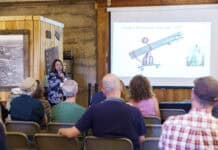Age: 75
Time in Sedona: 19-year resident, 33-year Sedona property owner
Background: Carol and I have been together for 47 years. We met at Beckman Instruments. We moved to Sedona from California in 2005. My vast work experience begins as a janitor for Snappy Taco to director of manufacturing accounting for ConAgra Foods, Grocery Foods Division, worth $5 billion. When we moved to Sedona I was hired as the finance director for a small nutraceutical company called Nutri-Health in Cottonwood. My first affiliation with city government was as a member of the Budget Oversight Commission under the direction of Rob Adams. I was elected to City Council in May 2012. After eight years I retired from council and became active as a board member with several nonprofit organizations: The Coalition Against Human Trafficking, Sedona Symphony, Sedona Public Library and Sedona Area Veteran & Community Outreach as a flag-raiser on State Route 89A.
Q: How do you propose to amend, alter or repeal Sedona’s building codes to help solve the housing shortage?:
A: “First of all, I do not have a degree in civil engineering, electrical engineering or architecture; therefore, I have asked individuals in those fields for recommendations. But I will say that any and all codes that pertain to safety must be maintained.
“City staff is correct about the obstacles. The term ‘red tape’ is often used here. There have been too many times when an accepted compliance was agreed to, but later the goal post was moved again. These last-minute changes must be reduced or eliminated.
“The land and building codes need to be reviewed on a partnership basis for a better understanding on both sides. Current codes are very onerous. I believe that developers, contractors and the Community Development Department need to convene regularly to understand each other’s concerns and potential obstacles that delay the building process. Easing restrictions on accessory dwelling units will not answer the affordable housing questions in Sedona.”
Q: Council has committed to the future use of the Sedona Cultural Park being decided by the public. What is your view on how that process should be conducted? Do you support or oppose the restoration of the amphitheater?
A: “First and foremost, I was totally against the purchase of the Cultural Park. Especially the amount of money, $23 million that was paid to acquire this 41-acre piece of property, which required a bond of $10 million against future tax revenue. What made this purchase ridiculous was that just down the road toward Cottonwood — 2.9 miles away — the city already owns over 200 acres.
“I would like to see the city lease the Cultural Park property to the Cultural Park 2.0 organization to restore the amphitheater to its once-glorious self. This idea was mentioned in the 2014 Community Plan. The day council purchased the Cultural Park, their reasoning was the fact that vacant land was scarce in Sedona and they did not know at the time what they wanted to do with this parcel, but it was available. Workforce housing was not mentioned. The geology and topography will require millions of dollars to bring it to a workable state for future development.
“Workforce housing should be planned at the Dells. The geology and topography lend itself to a lower cost for development. Build a place where residents want to live and be proud of their community. A sense of place where open spaces can have ponds, playground areas, shops, cafes, etc. If you can imagine it, it can happen.”
Q: Council has said short-term rentals are an obstacle to affordable housing in Sedona. What can council do to reduce STRs? What can council bring the median home price down to where it’s affordable for median-income residents?
A: “My answer in two words? Goldwater Institute [a Phoenix-based conservative public policy think tank]. Any and all current STRs will remain STRs under the grandfather clause if the legislature were to enact changes to the current law. If the city is to affect change in the future it must pass the state legislature, which would require a change in the political party mix.
“In discussions with current STR owners, capital market forces are driving down the asking price for daily, weekend and weekly rentals. If this continues, maybe we will start to see property changing hands to home ownership. Obviously deed restrictions on any new properties being built prohibiting short-term rental must seriously be considered.”
Q: How do you suggest the city act to increase home ownership among workers?
A: “Again, deed restrictions on any new properties being built prohibiting short-term rental must seriously be considered.
“Workforce housing programs work in other locations. They would be new, affordable with a deed restriction to 3% annual appreciation. Several other guardrails can be put in place.
“The Dells, with city financial assistance, is the perfect location to build affordable housing for residents. Lease the land for an extremely low price from the city and use the housing fund to pay for all impact fees. What is left to calculate a price for a home or unit is the cost of material and labor from the developer.
“As above, capital market forces are driving down the asking price for daily, weekend and weekly rentals. If this continues maybe we will start to see property changing hands to home ownership.”
Q: The English town of High Wycombe has had the custom since 1678 of annually weighing the mayor in public to see if he’s growing fat off the public purse. What are your thoughts on the introduction of such a tradition in Sedona?
A: “Sure, this would make for a great deterrent. Also, Carol would be extra happy to see that I stay healthy as mayor.”
Editor’s Note:
John Martinez, a former Sedona vice mayor and councilman, is challenging incumbent Mayor Scott Jablow. Election day is Tuesday, July 30.
